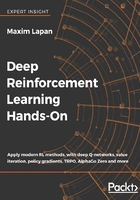
Theoretical background of the cross-entropy method
This section is optional and included for readers who are interested in why the method works. If you wish, you can refer to the original paper on cross-entropy, which will be given at the end of the section.
The basis of the cross-entropy method lies in the importance sampling theorem, which states this:

In our RL case, H(x) is a reward value obtained by some policy x and p(x) is a distribution of all possible policies. We don't want to maximize our reward by searching all possible policies, instead we want to find a way to approximate p(x)H(x) by q(x), iteratively minimizing the distance between them. The distance between two probability distributions is calculated by Kullback-Leibler (KL) pergence which is as follows:

The first term in KL is called entropy and doesn't depend on that, so could be omitted during the minimization. The second term is called cross-entropy and is a very common optimization objective in DL.
Combining both formulas, we can get an iterative algorithm, which starts with  and on every step improves. This is an approximation of p(x)H(x) with an update:
and on every step improves. This is an approximation of p(x)H(x) with an update:

This is a generic cross-entropy method, which can be significantly simplified in our RL case. Firstly, we replace our H(x) with an indicator function, which is 1 when the reward for the episode is above the threshold and 0 if the reward is below. Our policy update will look like this:

Strictly speaking, the preceding formula misses the normalization term, but it still works in practice without it. So, the method is quite clear: we sample episodes using our current policy (starting with some random initial policy) and minimize the negative log likelihood of the most successful samples and our policy.
There is a whole book dedicated to this method, written by Dirk P. Kroese. A shorter description can be found in the Cross-Entropy Method paper by Dirk P.Kroese (https://people.smp.uq.edu.au/DirkKroese/ps/eormsCE.pdf).